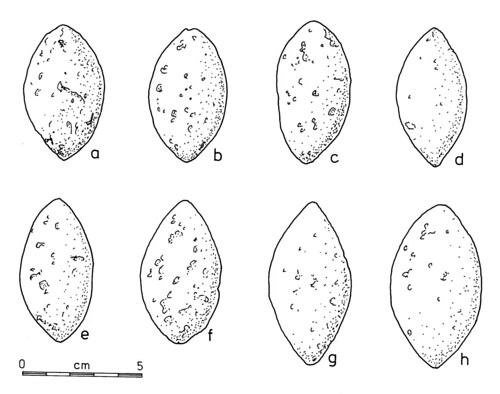Åcho’ atupat
Slingstones were used as weapons by ancient CHamoru warriors. Slingstones are stones of various sizes sharpened at both ends and hurled from a sling with deadly force in combative times. Called åcho’ atupat in CHamoru, slingstones were fashioned from either limestone, basalt, or fire-hardened clay and were hung from slings of pandanus or coconut fiber, the latter being far more durable.
What is most noted about these stones in early accounts is that ancient CHamorus used them with deadly accuracy. Though commonly associated with weaponry of the Latte period, these stones were used in early colonial history as the arms of resistance to Spanish colonization, hurled at the harbingers of that particular destruction. A prized art of warfare, the knowledge of how to fashion and hurl these stones was in the men’s domain.
One account by Father Pedro Coomans in The History of the Mariana Island Mission for the 1667-1673 period describes the weapons as such:
Their offensive weapons include the sling, which they aim very skillfully at the head. Out of small ropes they weave a sort of net-bag, in which to carry stones with an oblong shape, some formed out of a marble stone, and others of clay, hardened in either the sun or fire. They whirl and shoot those so violently. Should it make an impact upon a more delicate part, like the heart, or the head, the man is flattened on the spot. Then, if envy would make them want to burn a house from a distance, they would stuff the perforated side of it with tow burning with a very ferocious fire, which, with a swift movement became a flame, and sail away to seek shelter in enemy houses.
Over much of the world, slingstones were little more than naturally occurring rocks and pebbles. In contrast, Marianas slingstones were laboriously manufactured from a variety of materials, including coral, limestone, basalts, and clay. Raw materials were chipped and abraded into a variety of aerodynamic shapes, or when clay was used for slingstones, rolled and sunbaked or fired.
Most favored was the bipointed ovoid style that resembles American or Rugby mini-footballs. Others were made into more diamond and egg like shapes. The vast majority of Marianas slingstones are hand sized, weighing from 40 to 80 grams, though a few exceed one kilogram in weight. These are thought to have been ceremonial but perhaps some served utilitarian purposes, such as canoe breakers as seen in Tahiti and Hawaii. Finish quality varied, but many Marianas slingstones truly qualify as works of art.
Though the sling may have been used on Guam for bird hunting, it was primarily a combat weapon. Early Spanish chronicles attest to the prowess of CHamoru warriors in hurling slingstones with such deadly accuracy and force it was as though they were fired from a gun.
The CHamoru people have been in the Mariana Islands for at least 3500 years and possibly as long as 4600 years. However, identifiable slingstones do not show up in the archaeological record until around 2000 years ago, and this amounts to only a few recovered from Tarague Beach on Guam and the Teteto-Guata Site on Rota. Overwhelmingly, slingstones are associated with the Latte Period of Mariana’s prehistory, beginning some 800-1000 years ago. This marked proliferation of slingstones probably signals the advent of warfare.
A question that has not been satisfactorily answered concerns the origin of Guam’s sling technology. Some archaeologists have argued for independent development of sling weaponry or introduction possibly from the Philippines. Interestingly, to date, no antecedent technology has been identified in the Philippines or other candidate areas of Southeast Asia. It is far more likely that, at least conceptually, the sling and football shaped slingstones were introduced from Melanesia – the best bet would be from the Bismarck Archipelago, which are group of islands located off the northeastern coast of New Guinea. In the Bismarcks, slingstones have been dated to 2000-2400 years ago and in the Santa Cruz-Reef islands to 3100 years ago.
Archaeological knowledge revealing the origins and spread of the sling in Oceania will contribute to answering persistent questions concerning possible pre-European connections with the Americas. Though football shaped slingstones appear to be unknown in island Southeast Asia until about 3100 years ago, they have roots that go back possibly for more than 8000 years on the west coast of the continental United States. The slingstone was also the projectile weapon of the Inca and the preceding Andean cultures of South America.
Guam, however, is the world’s only political entity that features the slingstone on its seal and flag.
By Robert York, Gigi York, and Julian Aguon
For further reading
Cunningham, Lawrence J. Ancient Chamorro Society. Honolulu: Bess Press, 1992.
Russell, Scott. Tiempon I Manmofo’na: Ancient Chamorro Culture and History of the Northern Mariana Islands. Saipan: Commonwealth of the Northern Mariana Islands Division of Historic Preservation, 1998.
Spoehr, Alexander. Marianas Prehistory: Archaeological Survey and Excavations on Saipan, Tinian and Rota. Fieldiana: Anthropology. Vol. 48. Chicago: Chicago Natural History Museum, 1957.
Thompson, Laura M. Archaeology of the Mariana Islands. 1932. Reprint, New York: Krause Reprint Co., 1971.





